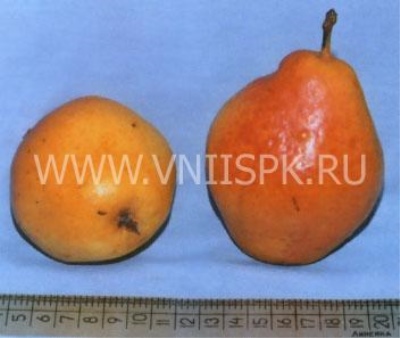
- Authors: P. P. Kostyk, A. I. Tereshchenkova, L. V. Khachetlova, selection SKNIIGiPS
- Appeared when crossing: pollination of a Kieffer seedling with a mixture of pollen (Forest Beauty + Bere Ardanpon + Bere Bosk)
- Name synonyms: Nart
- Fruit weight, g: 270
- Ripening terms: early winter
- Fruit picking time: from the end of September
- Appointment: dining room
- Growth type: medium height
- Yield: medium
- Transportability: good
For many years, Pear Nart has occupied a leading position in the popularity rating among similar crops among both amateur gardeners and professional farmers. These indicators are preserved not only due to the excellent taste of the fruit, but also due to the unpretentiousness of the variety, resistance to the most common diseases, stable fruiting, as well as the transportability of fruits and their long storage period.
Breeding history
Pear variety Nart (Nart) is the result of painstaking work of breeders of the Research Institute of the North Caucasian District. The greatest activity was shown by such scientists as P.P. Kostyk, A.I. Tereshchenkova and L.V. Khachetlova.The culture was obtained by pollination of the Kieffer seedling with pollen of the following varieties:
- Forest beauty;
- Bere Ardanpon;
- Bere Bosk.
Description of the variety
The Nart pear variety belongs to the early winter species; regions with a warm and mild climate are optimal for its growth. Despite the high trunk, the mature tree has a wide-pyramidal crown without thickening. The bark of the trunk and branches is colored light brown, and the shoots are deep brown.
Almost horizontal branches have dense foliage, the leaves are directed upwards. The dark green oval leaf plates are very large. The surface of the leaves is shiny, the edges are small-town. The petiole is medium, thick, with a small lanceolate stipule. The thick peduncle, located in a small funnel, is of medium size and slightly curved.
Large white flowers with a deep-set bowl-shaped corolla. Fruits in most cases appear on branched ringlets. Advantages:
- resistance to low temperatures and climatic fluctuations;
- immunity to viral diseases;
- lack of pauses in fruiting;
- high taste indicators;
- transportability.
Disadvantages:
- self-infertility;
- rare crown;
- frequent damage by pests.
Fruit characteristics
This variety is large-fruited. The standard weight of fruits is 250-270 g. In favorable climatic conditions, the weight of fruits can reach 500 g. Ripe fruits have a diamond-pear-shaped regular shape. The color range of ripe fruits varies from pale yellow to deep yellow. Ripe fruits have reddish sides.
A distinctive feature of the fruit is the absence of rustiness. Fruits are very rarely covered with a brown mesh and are practically not prone to cracking. The crumbling rate is average.
The fruit has a juicy pulp of moderate firmness, fine-grained structure with small granulations. The color of the pulp is white-yellow. The skin is thick with a glossy sheen. The subcutaneous points are very small and almost invisible. Chemical composition of fruits:
- dry matter - 12.5%;
- sugar - 10.0%;
- titratable acids - 0.13%;
- ascorbic acid - 1.9 mg per 100 g.
The fruit has a long shelf life, which can last until the New Year holidays, as well as high marketability and good transportability.
Taste qualities
This variety has a table purpose and has excellent taste characteristics. The pulp is very juicy, sweet with slight hints of sourness. It should also be noted that the fruit has a Kieffer flavor.
Ripening and fruiting
A distinctive feature is the early fruiting period, which begins already 3-4 years after planting, as well as the regular formation of fruits.
Mass ripening of fruits occurs at the end of September. Full ripening of the fruit and a set of juiciness occur 10-14 days after the fruit is removed from the tree. The fruits retain their high taste characteristics until January.

Yield
Average yield - 340 c / ha.
Self-fertility and the need for pollinators
This pear variety belongs to self-fertile ones, which are not capable of self-pollination. The best pollinating varieties:
- Pass-Crassan;
- Bere Ardanpon.
Landing
To get a strong plant, it is better to plant seedlings in the fall 1.5 months before the onset of cold weather. This period will be enough for the rooting of young shoots. If necessary, a transplant can be carried out in early spring. The soil in the planting pit should consist of the following components:
- fertile soil;
- sand;
- peat;
- humus;
- wood ash.
After planting young seedlings, they must be fixed to a vertical support. It is strictly forbidden to deepen the root collar. After sprinkling the roots with earth, the plant must be watered abundantly and the root zone must be mulched.


Growing and care
The pear of the Nart variety belongs to unpretentious plants, therefore it does not require increased attention and special agrotechnical methods. Plant care consists of the following activities:
- watering according to weather conditions;
- loosening the root zone;
- crown formation;
- top dressing with organic and mineral fertilizers;
- protection against diseases and pests;
- preparation for the winter of young seedlings.




Like any other fruit trees, the pear needs protection from various diseases and pests. When planting a pear on your site, you need to know in advance what diseases you should beware of. To successfully carry out the struggle, it is necessary first to correctly identify the cause of the problem. It is important to distinguish signs of disease from manifestations of the presence of insects, mites, caterpillars and other types of pests.





































































